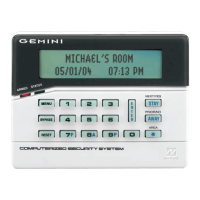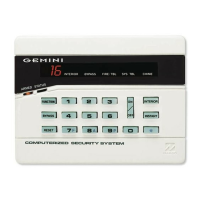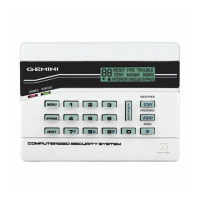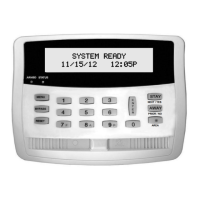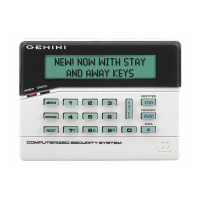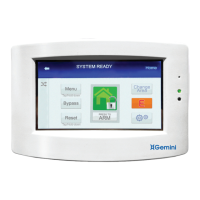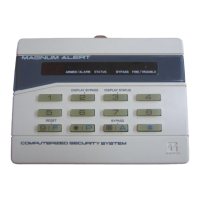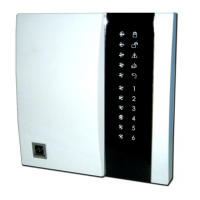Do you have a question about the NAPCO GEM-RP1CAe2 and is the answer not in the manual?
Describes the GEM-RP1CAe2 as a smart, user-friendly, interactive menu-driven keypad.
Instructions for weekly testing of sounding device, backup battery, and communicator.
Displays system status messages, zone descriptions, and other operational information.
Explains the meaning of the green STATUS and red ARMED lights.
Details the purpose of FUNCTION, BYPASS, RESET, Numerical, ON/OFF, INTERIOR, and AREA buttons.
How to use specific buttons in conjunction for emergency signaling.
Guides users through checking system readiness and arming the system before leaving.
Explains the system's response and user actions for priority arming with faulted zones.
Instructions on how to selectively bypass zones that cannot be secured.
Procedures for addressing system trouble messages when attempting to arm.
How to arm or disarm individual areas in a partitioned system.
Describes the functionality of Manager's Mode for controlling different areas.
Explains how to arm all system areas simultaneously.
How to bypass interior zones to allow free movement within the home.
System's automatic bypassing of interior zones when armed and occupied.
How to arm the system for instant alarm response upon entry.
Allows users to exit the premises after arming with a programmed exit delay.
How to activate Fire, Auxiliary, or Police emergency signals.
Steps required to disarm the system upon returning to the premises.
How to silence an audible alarm and identify the zones that triggered it.
Explains the use of an Ambush Code to send a silent alarm to the central station.
Actions to take during a fire alarm, including silencing and evacuation.
Procedures for identifying and resolving trouble conditions within the fire circuit.
Guidance on creating and rehearsing a fire escape plan for the premises.
Crucial escape procedures and safety tips to discuss with household members.
Contact information for obtaining additional fire safety resources.
Space provided to draw a plan of the premises for fire escape planning.
Explains potential failure points and inherent limitations of fire alarm systems.
How to enter the function menu and navigate through its options.
Functions to display zone faults, bypassed zones, and zone directory details.
Functions for activating system tests and displaying alarms/troubles.
Features for activating chime and watch modes for zone monitoring.
Procedures for resetting system troubles and sensor watch failures.
Manually starting the exit delay, often used in commercial systems.
How to activate a telephone test to verify communication with the central station.
Setting the system to arm automatically after a specified delay period.
Activating program mode and installer download features.
Managing programmed relay groups for controlling external devices.
Details on the digital communicator, abort delay, and opening/closing reports.
Procedures for bypassing or unbypassing system zones.
Managing exit delay based on ringback signals or restarts.
How to enter the mode for programming user codes, zone descriptions, and system settings.
Steps for programming, reprogramming, and erasing user access codes.
Viewing programmed user codes and exiting the programming mode.
Assigning custom text descriptions to system zones.
Method for entering zone descriptions using a keypad-like interface.
How to set the system's current date and time display.
Explains messages related to system readiness, arming, and delays.
Describes messages indicating open zones, arming restrictions, or zone troubles.
Messages indicating active alarms, fire troubles, and fire alarms.
Messages related to invalid codes, denied access, or arming prevention.
Messages concerning alarm reporting, cancellation, and central station communication.
Messages for common system troubles like power failure, low battery, and communication issues.
Definitions for terms starting with A through E, covering system components and functions.
Definitions for terms starting with E through S, covering system operations and states.
Definitions for terms starting with U through Z, covering user codes and zone types.
Explains error codes E01-00, E02-00, E03-00 for power, battery, and communication failures.
Error codes related to wireless transmitters, receivers, and telephone line issues.
Error codes for keypad tampering, expansion modules, and keyfob batteries.
Error codes related to programming, sensors, bus failures, and printers.
Error codes for RF self-tests, fire systems, bells, telemetry, and detectors.
Guidance for issues preventing system arming, like open or faulted zones.
Steps to take when the system indicates a trouble condition with error codes.
Procedures for silencing and responding to a sounding fire alarm.
